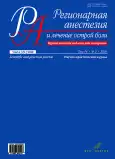Programmed intermittent epidural boluses (pieb) for labor analgesia: study of the sensor block and effects on maternal motor function
- 作者: Upryamova E.Y.1, Shifman E.M.2, Krasnopolskij V.I.1, Ovezov A.M.2
-
隶属关系:
- Moscow Regional Research Institute of Obstetrics and Gynecology
- M.F. Vladimirsky Moscow regional Research and Clinical Institute
- 期: 卷 14, 编号 2 (2020)
- 页面: 63-71
- 栏目: Original articles
- URL: https://journals.rcsi.science/1993-6508/article/view/55467
- DOI: https://doi.org/10.17816/1993-6508-2020-14-2-63-71
- ID: 55467
如何引用文章
详细
Background. Programmed intermittent epidural boluses (PIEB) technique is a promising approach that demonstrates certain advantages over traditional techniques of epidural analgesia. We compared the dynamics of the sensory block of PIEB + parturient-controlled epidural analgesia (PCEA) with continuous epidural infusion (CEI) + PCEA for maintenance labor analgesia and the incidence of motor block (MB) in women who received PIEB or traditional techniques.
Methods. A total of 165 subjects were studied. All parturients were divided into five groups: manual boluses, PCEA, PCEA + CEI, PIEB + PCEA; levobupivacaine 0.25 mg/mL; 1.25 mg/mL; 0.625 mg/mL. The level of the MB was evaluated by the classic Bromage scale (0-1-2-3). The level of the sensor block was evaluated by the pin-prick test.
Results. MB was reported in 80% in group 1 120 min after analgesia, 78% and 52% in groups 2 and 3 at the 150th min (p < 0.001); in group 4, the MB frequency was 6% 15 min after the start and was increasing to 40% at full cervical dilation (p < 0.001). In group 5, the relative MB frequency did not exceed 10% at the 120th min and was 0% at full cervical dilation (p < 0.00001). The results indicate that in the PIEB group, the level of sensory block in patients was higher 15 min after the start of analgesia and remained so until the end of the observation period [median PIEB Th5 versus Th8 in the CEI group, (p < 0.0004)].
Conclusions. PIEB + PCEA technique maintained a consistently high level of sensor block throughout the study compared to PCEA + CEI, which ensured effective analgesia in the first and second stages of labor with minimal MB.
作者简介
Ekaterina Upryamova
Moscow Regional Research Institute of Obstetrics and Gynecology
编辑信件的主要联系方式.
Email: katerinaupryamova@gmail.com
ORCID iD: 0000-0002-7057-2149
MD, PhD, Head of Anesthesiology and Critical Care Department
俄罗斯联邦, 101000, Moscow,E. Shifman
M.F. Vladimirsky Moscow regional Research and Clinical Institute
Email: katerinaupryamova@gmail.com
ORCID iD: 0000-0002-6113-8498
俄罗斯联邦, 129110, Moscow
V. Krasnopolskij
Moscow Regional Research Institute of Obstetrics and Gynecology
Email: katerinaupryamova@gmail.com
俄罗斯联邦, 101000, Moscow
A. Ovezov
M.F. Vladimirsky Moscow regional Research and Clinical Institute
Email: katerinaupryamova@gmail.com
ORCID iD: 0000-0001-7629-6280
俄罗斯联邦, 129110, Moscow
参考
- Upryamova E.Yu., Shifman E.M., Krasnopol’skij V.I., Ove- zov A.M. Programmed Intermittent Epidural Boluses (PIEB) for labor pain relief. Anesteziologiya i reanimatologiya. 2020;4:68-76. doi: 10.17116/anaesthesiology202004169. (in Russ.)
- Xu J., Zhou J., Xiao H., Pan S., Liu J., Shang Y., Yao S. A Systematic Review and Meta-Analysis Comparing Programmed Intermittent Bolus and Continuous Infusion as the Background Infusion for Parturient-Controlled Epidural Analgesia. Sci Rep. 2019;22;9(1):2583. doi: 10.1038/s41598-019-39248-5.
- Carvalho B., George R.B., Cobb B., McKenzie C., Riley E.T. Implementation of Programmed Intermittent Epidural Bolus for the Maintenance of Labor Analgesia. Anesth Analg. 2016;123(4):965-71. doi: 10.1213/ANE.0000000000001407.
- Neuroaxial methods of labor pain relief. Clinical guidelines (treatment protocol). Approved by the Ministry of Health of the Russian Federation No. 15-4/10/2-6914; 2018. (in Russ.)
- Curatolo M., Petersen-Felix S., Arendt-Nielsen L. Assessment of regional analgesia in clinical practice and research. Br Med Bull. 2005;31;71:61-76. doi: 10.1093/bmb/ldh035.
- Wang T., Shen S., Shao-Qiang H. Effects of Epidural Labor Analgesia With Low Concentrations of Local Anesthetics on Obstetric Outcomes. Anesth Analg. 2017;124(5):1571-80. doi: 10.1213/ANE.0000000000001709.
- Sultan P., Murphy C., Halpern S., Carvalho B. The effect of low concentrations versus high concentrations of local anesthetics for labour analgesia on obstetric and anesthetic outcomes. Can J Anaesth. 2013;60:840-54. doi: 10.1007/s12630-013-9981-z.
- Barbé A., Roofthooft E., Devroe S., Van de Velde M. Programmed intermittent epidural boluses (PIEB) in labor analgesia: a narrative review of the present. Acta Anaesth. Belg. 2019;70:11-21.
- Xu J., Zhou J., Xiao H., Pan S., Liu J., Shang Y., Yao S. A Systematic Review and Meta-Analysis Comparing Programmed Intermittent Bolus and Continuous Infusion as the Background Infusion for Parturient-Controlled Epidural Analgesia. Sci Rep. 2019;22;9(1):2583. doi: 10.1038/s41598-019-39248-5.
- Gabriel L., Young J., Hoesli I., Girard T., Dell-Kuster S. Generalisability of randomised trials of the programmed intermittent epidural bolus technique for maintenance of labour analgesia: a prospective single centre cohort study. British Journal of Anaesthesia. 2019;123(2):e434-e441. DOI: https://doi.org/10.1016/j.bja.2019.02.016.
- Hogan Q. Distribution of solution in the epidural space: examination by cryomicrotome section. Reg Anesth Pain Med. 2002;27(2):150-6.
- Capogna G. Maintenance of labor analgesia. In: Epidural Labor Analgesia: Childbirth Without Pain. Switserland. Springer. 2015;89-101.
- Kenichi Ueda, Wasa Ueda, Masanobu Manabe. A Comparative Study of Sequential Epidural Bolus Technique and Continuous Epidural Infusion. Anesthesiology. 2005;103(1):126-9. doi: 10.1097/00000542-200507000-00019
- Kaynar A.M., Shankar K.B. Epidural infusion: continuous or bolus? Anesth. Analg. 1999;89(2):534.
补充文件






